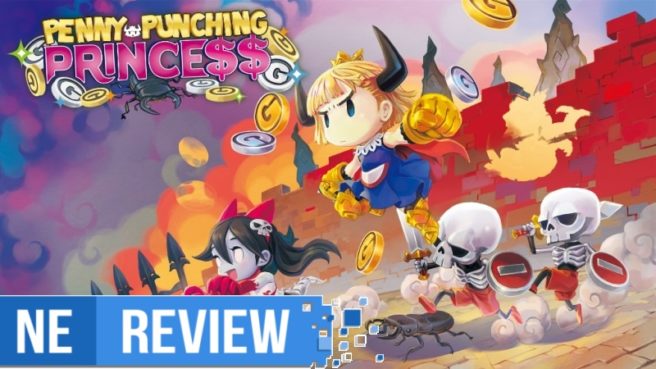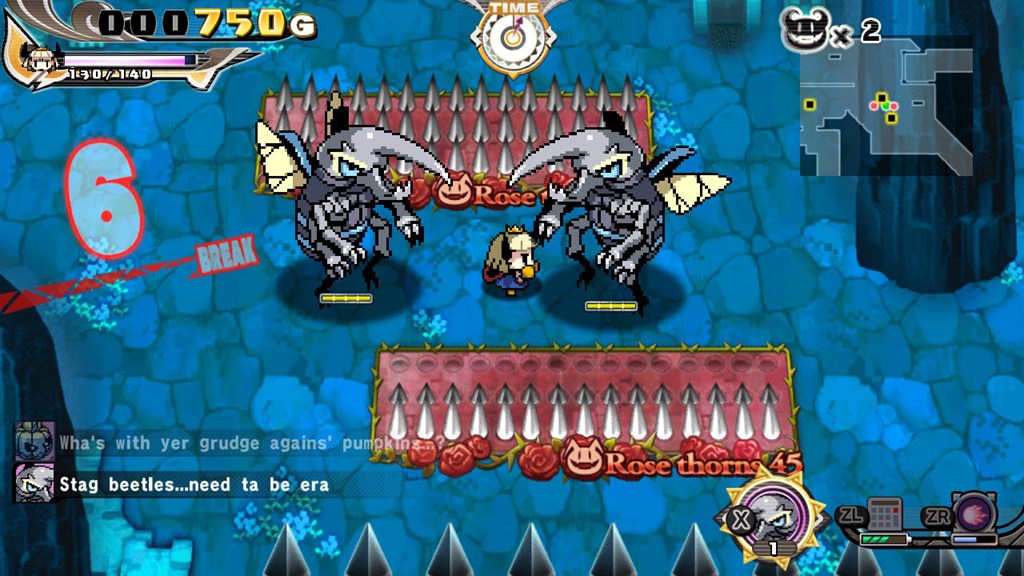[Review] Penny-Punching Princess
System: Switch
Release date: April 3, 2018
Developer: Nippon Ichi
Publisher: NIS America
Penny-Punching Princess checks all the right boxes in things I love: it’s got arcade-inspired gameplay in which you’ll brawl your way through dungeons (or castles) in a level, a section by section format that is reminiscent of classics like Double Dragon or Streets of Rage, a simple light and heavy attack button that you can mix and match for combos, and a very straight-forward approach in how to complete each level. Racking up points and cash so you can bribe, upgrade, and loot your way to victory is also an intriguing element, and the adorable pixel art style looks nice. However, all of the enjoyment is quickly interrupted thanks to non-intuitive controls, uninspired levels, repetitive gameplay, and a story that’s so banal and aimless you’ll find yourself either falling asleep to the dialogue or skipping the text entirely.
The name couldn’t be more accurate in describing your role in the game. You’ll play as a princess, simply known as Princess, who’ll be punching her way through her country that’s been overtaken by a force known as the Dragaloan Family. Her father had a massive debt before he passed and everything was acquired by the Dragaloans, and now you’ll be fighting your way through their army and capitalistic society to regain what’s yours and get super rich in the process.
That’s the gist of the entire game and it won’t be going in any deeper than that. The princess rarely speaks because her beetle butler, Sebastian, is a bit of a loud mouth and typically will speak on her behalf, talking all the smack in the world while she lays the beatdown – it’s very much a Paul Heyman and Brock Lesnar situation. They all have “voices”, but it’s gibberish – similar to Banjo – outside of the narrator that will periodically give a summary of the events that have unfolded like a fairy tale book. There’s an option in the menu to change voices between Japanese and English, but this will just affect the narrator – otherwise everything else stays the same.
As you progress through the game you’ll acquire large amounts of money, and while that may sound enticing, the money is mostly used while actually going through each level to bribe and acquire, while outside of levels you’ll be at your castle where you can upgrade your skills, armor, and more. However, these will usually require an allotment of monsters and weapons you’ve invested in along the way so they can lend their services to you. It’s not a particularly efficient way of upgrading, as not everything will have a 100% success rate, and you can only bribe so many things at once (usually one at the beginning but more as you go), and it’s a slow going process. Things can get relatively tough early into the game too if you’re not managing your stats right. You’ll be given experience points as you level up to be put towards things like attack and defense to increase the base level of these attributes, but this is also a tedious process that requires heavy grinding in order to do anything worthwhile that sees and feels any kind of improvement during gameplay.
The calculator that’s used to bribe and help your way through majority of the game was bestowed upon you by the God of Money in order to help you regain your kingdom. It’s made apparent fairly soon, however, that this calculator that you’ll be using had no QA before the God came down and gave it to you.
There are two ways to “play” the game, and that’s in Button Mode and Touch Mode. This option is primarily for calculator usage, and obviously Touch Mode is disabled during TV play. Either way, regardless of what you pick in handheld mode, both are a nuisance and difficult to manage.
In Button Mode, you’ll hold down ZL to bring up the calculator (if you have enough magic to use it), then use the d-pad to select the numbers you want to type in, A to input, and X when you want to trigger it and initiate the bribe on the monster, weapon, locked treasure, gate, or hazard in the way. The issue with this is – outside of gates and the occasional circle that’ll regenerate health points – you’ll always be in combat with a bunch going on between enemies and hazards like flamethrowing statues, saws riding rapidly across the ground, spiked holes, and more. Unfortunately, opening up the calculator doesn’t stop combat – things are still very much live and in action. If you’re in Touch Mode while in handheld, the calculator is just out of reach from your thumb (your mileage may vary on this but I have small hands), meaning you’re basically forced to either hold the Switch with one hand and type in or set it down entirely. Yet then I found ZL periodically let go because of this odd position you’re in (bless digital inputs for the triggers, right?), causing you to have to start over.


